Pantheus
– All God With YHW / IAW Inscriptions
This study is dealing with the later Greco-Roman time period belief system of the Pantheus, the All God. Pantheus incorporated YHWH into the All God assimilation, inscribing the name IAW / IAO on amulets for protection. Names of the supreme male deities became not just names, but talismans to ward off evil when spoken in prayers, incantations and worn as amulets. Though this element does get into Gnosticism, I feel that it is important to be knowledgeable of it for a number of reasons: Gnostic elements are very heavy in a variety of books of the Tanak/ Bible and the New Testament; recognizing the symbolism used helps us to understand what the earlier belief systems believed and the progression from one application to another; and it also helps to chronicle when changes occurred so that we do not take a first century CE belief system and impose it on a 2000 century BCE belief system, falsely teaching that was the way it has always been.
To set the stage for the following inscriptions, I need to quote Samuel Angus’ Mystery Religions and Christianity, written in 1925, but reprinted in 2003 by Kessinger Publishing LLC. The pages quoted are 190 and 191.
“The Romans were the greatest borrowers and most skillful adapters. Their syncretistic tendencies were accentuated by their Greek education and the influence of Greek literature. Into their pantheon they admitted Etruscan, Italian, Greek and Oriental deities. Between the Second Punic War and the rise of the empire, Roman religion was completely Hellenized in cult and in mythology; the taste for Oriental cults developed, which finally drew the people away from Greek and Roman deities, though it left them Greek Mythology.
Polytheism was tolerant and hospitable to foreign deities;
it never disputed the existence or reality of other deities, and the addition
of a new member to the Pantheon was a matter of indifference. The Greeks had
early adopted a process of theocrasia (mingling of attributes of several
deities into one); from
During this time of Hellenization, we see quite a number of stones and amulets that feature this pantheus figure. At times this figure is inscribed with the names of IAW / IAO, Abrasax / Abraxas or another dominant male deity name. The inscriptions are in either Phoenician / Hebrew, Aramaic and or Greek. Many of these images have been carved on gem stones and are believed to be amulets to ward off evil. The form of the image pictured in this study has been termed anguipede. The anguipede (snake footed) is a male in Roman military garb (war god), with the head of a rooster (occasionally a lion) and the legs of serpents. He is frequently depicted with a shield in one hand and the whip of Helios in the other. Sometimes the IAW is right to left, such as Phoenican / Hebrew and other times it is in left to right as the Greek of the time. Below are three line drawings, for clarity, of three stones which show the basic anguipede figure with IAW written right to left, the center image showing the sun chariot with the anguipede driving it and Sabao / Tsabaoth written in Greek underneath and the third has the inscription of a variant spelling of YHWH – IAWAHH.
Please be aware of Greek letter to Hebrew letter associations. The Greeks used their Iota for the Hebrew Yod, which is the same letter in the more ancient Phoenician alphabet. The W was representative of the Waw in Hebrew, sometimes represented as an O, which is why you see some inscriptions as IAW or IAO. In the case of sabaw / tsabaoth (armies, hosts) as in YHWH Tsabaoth – YHWH of the Armies, the Greeks did not have a Ts (tsadde) letter and simply used the Sigma.
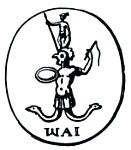
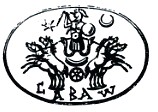
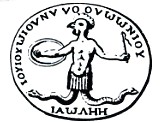
Clearly the rooster head and Helios association is solar. The small figure on the head of the first line drawing is that of Ares, the god of war. As to the serpents, prior to the heavy editings and associations of the patriarchal Jewish scribes and the priesthood, they were not a symbol of a satan / devil, but rather was associated with YHWH and was called Nechushthan / Nehustan, which is dealt with later.
Below is an IAW amulet carved on gray agate. You can clearly see the IAW on the shield.
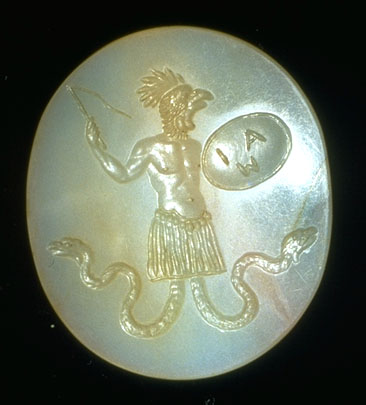
The next image is an amulet carved on black steatite with IAW incised around the figure.
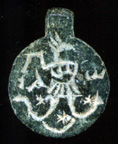
This next one is incised in rock crystal, depicting a lion with a star. The inscription: IAW EULAMW ABRASAX (Iao Eulamo Abrasax)
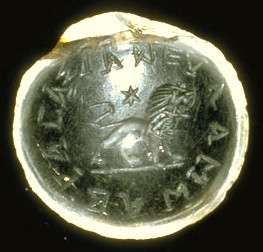
The hanging pendant has another lion with a serpent. The inscription: IAWTh SABAWTh MIChHL (Iaoth Sabaoth Michael)
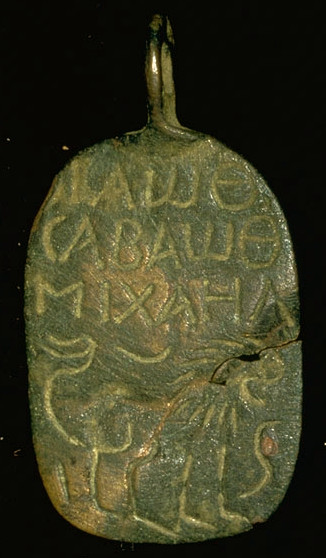
Other inscriptions on the stones have included: IAW Abrasax you are lord, Abrasax IAW MThRAZ (Mithras showing the association between solar deities), IAW Adonaie, Adonai Abrasax.
Not all of the inscribed stones are from the time of Basilides, some of them date before the first century when Gnosticism (Greek, Jewish and Persian) began increasing in influence and numbers.
Those inscriptions that deal with Abrasax / Abraxas can be
easily dated to the first century CE, for the earliest date. That is the time
period of an early Gnostic teacher named Basilides. He taught from 117-138 CE,
in
Tertullian (160-220 CE), Against Heresies, Chapter 1
“Afterwards broke out the heretic Basilides. He affirms that there is a supreme Deity, by name Abraxas, by whom was created Mind, which in Greek he calls Νοῦς; that thence sprang the Word; that of Him issued Providence, Virtue, and Wisdom; that out of these subsequently were made Principalities, powers, and Angels; that there ensued infinite issues and processions of angels; that by these angels 365 heavens were formed, and the world, in honor of Abraxas, whose name, if computed, has in itself this number. Now, among the last of the angels, those who made this world, he places the God of the Jews latest, that is, the God of the Law and of the Prophets, whom he denies to be a God, but affirms to be an angel. To him, he says, was allotted the seed of Abraham, and accordingly he it was who transferred the sons of Israel from the land of Egypt into the land of Canaan; affirming him to be turbulent above the other angels, and accordingly given to the frequent arousing of seditions and wars, yes, and the shedding of human blood. Christ, moreover, he affirms to have been sent, not by this maker of the world, but by the above-named Abraxas; and to have come in a phantasm, and been destitute of the substance of flesh: that it was not He who suffered among the Jews, but that Simon was crucified in His stead: whence, again, there must be no believing on him who was crucified, lest one confess to having believed on Simon. Martyrdoms, he says, are not to be endured. The resurrection of the flesh he strenuously impugns, affirming that salvation has not been promised to bodies.”
Nechushthan /
Nehustan
Now, let us examine the association of the serpent in relation
to YHWH in the more ancient applications before the New Testament. The first
account of the Nechushthan is when it is created in BeMidbar [Numbers] 21:5-9,
“and the people spoke against elohiym, and against Mosheh
[moses], 'why have you brought us up out of mitsrayim [
Nechushthan is defined as the serpent of brass made by Moses. Nachash – ygp is a snake, serpent. And nechsheth zygp is brass or copper. Please remember that in the Hebrew, HA at the beginning of a word is the article “the”.
The next time we see the reference to the Nechushthan is in reference to King ChizqiYahu [Hezekiah]. II Melekiym [Kings] 18:1-4, “and it happened in the third year of hoshea ben elah the king of yisrael, chizqiyahu ben achaz the king of yahudah began to reign. 2 he was a son of twenty five years when he began to reign, and he reigned in yerushalaim twenty nine years; and the name of his mother was abi the daughter of zekaryahu. 3 and he did the right in the eyes of YHWH, according to all that his father dawiyd did; 4 he took away the high places, and broke in pieces the pillars, and cut down the asherah, and beat to bits the bronze serpent that mosheh made, for in those days it was that the sons of yisrael burned sacrifices to it and called it nechushthan.”
Considering the fact that ChizqiYahu had an alliance with
Egypt, proven historically and in the Tanak, that archaeologically his seals
have Egyptian solar imagery on them, I do not see the reforms ascribed to him
as actually taking place, but were more likely those of YoshiYahu [Josiah],
which are described in much greater detail. Archaeologically, the four winged
seraf (winged serpent) never appear in the
What is important to note here, is that a pole with a
serpent of some sort on it was in the
Ancient Mother
Goddess Images of Serpent Legs
As with many other symbols and terms, syncretistically applied to YHWH or other deities, this anguipede symbol has its roots in the major mother goddess images. After the common images of about 2000 BCE and later, you see the mother nourishing the beasts, many of which include serpents on each side of her, sometimes being held in her hands or twined on her arms, such as the famous Minoan goddess statue from Knossos, Crete. Other times the serpent(s) are around the goddess, such as those with Athene and her later representations of the Gorgon Medusa with snakes for hair. Greek mythology also wrote of the monstrous Ekhidna / Echidna (she viper), the daughter of Gaia (Earth), was referred to as the Mother of all Monsters, who had the tail of a serpent for her lower body, sometimes depicted as the two serpents. Later the form is represented as her son. You can see the progression from time and territory, which leads to the 4th century BCE and the Indo-European Scythian / Sauromatian representations of their creatress mother goddess having serpent legs. Her name is Tabiti and Api. Below is a gold image found in a burial tomb at Kul Oba. Scythian art commonly employed symmetry in their art. So while some cultures showed the goddess as simply having a serpents tail, the Scythians made everything mirrored from one side to the other and created the dual serpent legs.
Minoan Serpent Goddess 1600 BCE
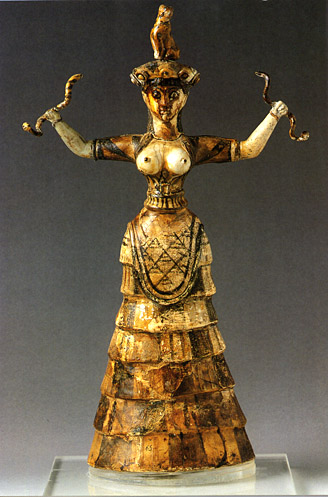
Minoan 850 BCE,
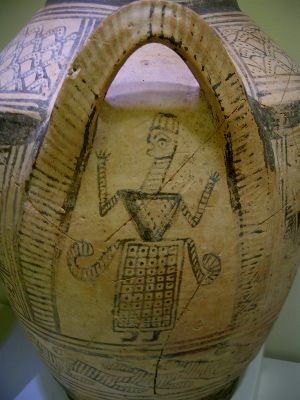
Scythian Api 4th century BCE
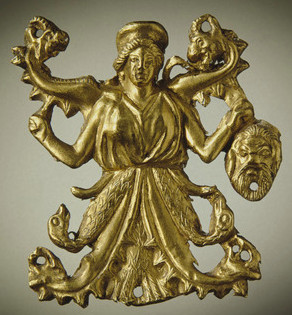
Also found in the 4th century BCE Scythian tombs was the frontlet for a horses head, bearing the same image of the anguipede goddess.
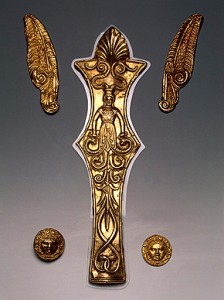
The later ancient empire of the pre-Islamic Kurdistani (same
Berehynja
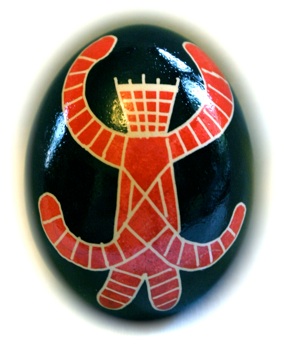
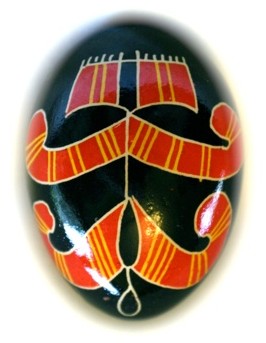
Shahmaran
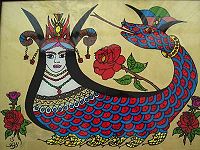
A statue from about 31 BCE, of unknown origin depicts “Isis”
with the serpents tail, as the other mothers goddess from the
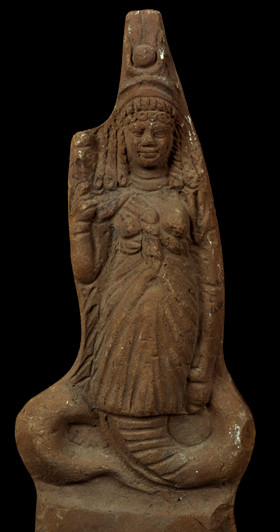
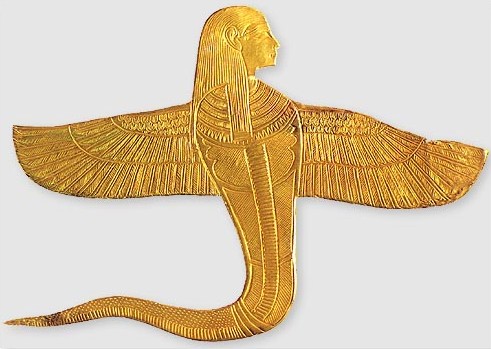
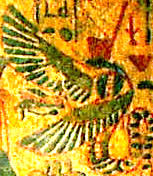
Within all these connecting cultures, the aspect of the mother goddess was also that of protectress, represented by the serpent. If you think about the agriculture groups that stored grain, which was necessary for the survival and growth of these groups, after the hunter gatherer cultures, what is a common enemy of stored grains? Rodents. Snakes, cats and predatory birds are the obvious predators of grain stealing rodents. Is it so far fetched that hunter birds, felines and serpents are common symbols to the mother cultures? With that it mind, you can see the progression from the mother goddess imagery to that of the pantheus, involving all three elements, but from a decidedly patriarchal, warrior Indo-European perspective.
The use of IAW / IAO as the supreme male god representative, is all the more understandable when you look at the origins of the name Iahu in the ancient Sumerian culture. For further information on linguistic origins, please see the Character of YHWH study.
